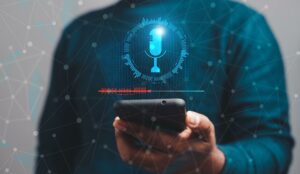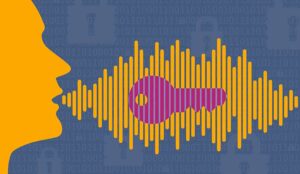Scams are evolving with frightening sophistication. Traditional passwords and security questions are no longer enough—they can easily be forgotten, lost, or even stolen. Contact centres are a target for fraudsters due to the volumes of data they handle and keep.
Voice biometrics, also known as voice authentication, is an AI-backed technology that offers a secure method of verifying customer identities, safeguarding data, and combating fraud. It is widely used in the contact centre to ensure the security of customer data, reduce call duration, and improve self-service.
In this article, we’ll explore:
- The definition of voice biometrics.
- How voice biometrics works.
- Different types of voice biometrics.
- The benefits of voice biometrics.
- How to start using voice biometrics.
Learn how to leverage voice authentication to create a more secure, efficient, and satisfying customer journey in your contact centre.
What is Voice Biometrics for Contact Centres?
Voice biometrics uses the unique characteristics in an individual’s voice to authenticate their identity. It records and analyzes several vocal attributes, such as pitch, accent, speed of speech, cadence, and tone, and considers physiological factors like the shape and size of the speaker’s mouth and throat. Together, these create a distinctive voiceprint, which is as unique as a fingerprint.
No two people have exactly the same vocal characteristics, making voice authentication a reliable and secure identification method, ensuring the person accessing the service is who they claim to be.
In a contact centre setting, voice biometrics enhances authentication protocols and bolsters security measures. Voice biometrics eliminates password fraud and other risk by using the customer’s voice as the password.
It also delivers a smooth and frictionless customer experience, with no need for special hardware like fingerprint identification or facial recognition. Customers can authenticate themselves using their voice, regardless of where or what device they are using.
How Does Voice Recognition Biometrics Work?
Voice recognition biometrics capture a voice sample from an individual and convert it into a unique voiceprint using complex algorithms.
This voiceprint is then stored and used for future verification. When someone tries to authenticate their identity, the system compares the live voice sample with the stored voiceprint. If the two match, the person is authenticated.
Voice recognition biometrics involves several steps:
1. Enrollment
The voice recognition system captures a voice sample from a known person. This sample can be obtained during a regular phone call or through a specific recording session that asks the person to speak certain phrases or sentences. This step aims to gather enough data to accurately represent the person’s unique vocal attributes.
2. Extraction
The system analyzes the captured voice sample to extract distinguishing characteristics. These include physiological factors such as the size and shape of the person’s vocal tract and behavioral aspects like accent, speech speed, and pronunciation.
3. Processing
These extracted features are then processed using complex algorithms to create a voiceprint—a digital representation of the person’s voice. This voiceprint serves as a template against which future voice samples will be compared.
4. Verification
The system captures a live voice sample when the person attempts to authenticate their identity. The features of this live sample are extracted and compared with the stored voiceprint. The system confirms the person’s identity if the two match closely enough.
In a contact centre, for example, a customer calls to discuss a recent purchase or to raise a query. Instead of going through the usual process of answering security questions or providing a password, the customer simply starts explaining their issue.
The voice recognition system analyzes their voice as they speak, comparing it with the stored voiceprint on file. If there’s a match, it verifies the customer’s identity.
Types of Voice Biometrics
There are two main types of voice biometrics technology: active and passive. The difference between them lies in the way the two methods capture and analyze voice samples.
Active Voice Biometrics
Active voice biometrics requires active participation from the user. The customer speaks a specific phrase or password, which the system then captures and analyzes. For example, a common phrase used in active voice biometrics might be “My voice is my password.”
Active voice biometrics is particularly useful in high-security situations where an additional layer of protection is necessary. The combination of the unique voiceprint and a specific phrase makes it hard for fraudsters to gain unauthorized access.
Passive Voice Biometrics
Passive voice biometrics provides a less intrusive and more user-friendly approach to voice authentication. Instead of requiring a specific phrase, this method analyzes the user’s voice during regular conversation. It uses advanced algorithms to extract unique vocal characteristics and compare them with the stored voiceprint for verification.
This method provides a seamless and hassle-free experience for customers. It’s especially useful in scenarios where a smooth customer experience is crucial, such as in customer service centres or telecommunication companies.
Advantages of voice biometrics
Voice biometrics technology in contact centres has shown significant potential in improving operational efficiency, customer satisfaction, and security measures. It can reduce handle time by 25 – 45 seconds.
Traditional customer authentication methods often involve multiple security questions or password verifications. With biometrics, however, identity verification is much faster through general conversations.
Using voice authentication in contact centres:
Improves Customer Experience
Traditional authentication methods often involve answering security questions or remembering complex passwords, which can be time-consuming and frustrating for customers.
Using biometrics eliminates this process. Customers use their voice to verify their identity, which makes the authentication process quick and effortless.
Voice biometrics also allows customer service agents to focus more on resolving the customer’s issue rather than verifying their identity. This reduces call duration and increases customer satisfaction.
Prevents Fraud Incidents
Identity theft and fraudulent account takeover attempts are significant concerns for many businesses, especially those dealing with sensitive customer information. Voice biometrics serves as a robust security measure to counter these threats.
The unique nature of everyone’s voice makes it extremely difficult for people to mimic or steal. Even if a fraudster obtains other personal details, they cannot replicate the customer’s unique voiceprint, preventing unauthorized access.
Reduces Costs
Implementing voice biometrics can lead to significant cost savings for businesses. By speeding up the authentication process, biometrics reduces the average handle time for customer calls. This efficiency means agents can work faster, reducing labor costs.
The enhanced security provided also reduces the costs associated with handling fraud incidents, such as investigating the incident, reimbursing customers, and repairing damage to the company’s reputation.
And because biometrics doesn’t require any specialized hardware, there are no equipment purchases or maintenance costs to implement it.
Getting Started with Voice Biometric Authentication Solutions
Voice biometric authentication solutions have revolutionized how businesses handle customer interactions, providing a secure and efficient method for verifying customer identities.
A solution leverages sophisticated biometrics technology to provide a seamless and secure customer authentication experience.
From enhancing data privacy and reducing fraud to improving the customer experience, this technology represents a significant step forward in secure and efficient customer authentication.
FAQs
How Accurate is Voice Biometrics?
Voice biometrics is highly accurate. It uses complex algorithms to analyze hundreds of unique voice characteristics to create a unique personal voiceprint for each customer, making duplication almost impossible.
How Secure is Voice Biometrics?
Voice biometrics is one of the most secure authentication methods. Since a voiceprint is unique to each individual, it’s extremely difficult for fraudsters to mimic or steal.
Does Voice Biometrics Work in Loud Environments?
Yes, biometrics can work in any environment, as the advanced system is designed to filter out background noise, focusing solely on the speaker’s voice.
What is the Difference Between Voice Recognition and Voice Authentication?
Voice recognition is the process of identifying who is speaking. In contrast, voice authentication confirms the person is who they claim to be by comparing their voice to a previously saved recording, or “voiceprint”.
This blog post has been re-published by kind permission of Talkdesk – View the Original Article
For more information about Talkdesk - visit the Talkdesk Website
Call Centre Helper is not responsible for the content of these guest blog posts. The opinions expressed in this article are those of the author, and do not necessarily reflect those of Call Centre Helper.
Author: Talkdesk
Published On: 28th Sep 2023 - Last modified: 9th Dec 2024
Read more about - Guest Blogs, Talkdesk






 Talkdesk is a global customer experience leader for customer-obsessed companies. Our contact center solution provides a better way for businesses and customers to engage with one another.
Talkdesk is a global customer experience leader for customer-obsessed companies. Our contact center solution provides a better way for businesses and customers to engage with one another. 


































